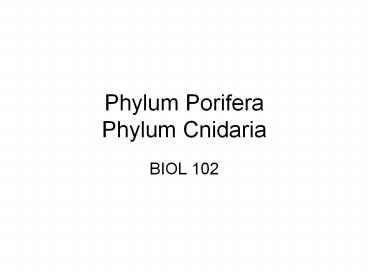Phylum Porifera Phylum Cnidaria PowerPoint PPT Presentation
1 / 23
Title: Phylum Porifera Phylum Cnidaria
1
Phylum PoriferaPhylum Cnidaria
- BIOL 102
2
- Phylum Porifera
- Upon completion of this lab, you should be able
to complete the objectives listed - on p.103.
- Know the poriferan classes listed on p.107.
- Observe the Grantia (Scypha) slide and find the
structures described on p.107-108. - Describe the flow of water through a syconoid
sponge. - Know all the key terms listed at the end of ch.
7. - Complete a life function sheet for this phylum.
- Phylum Cnidaria
- Know the cnidarian classes listed on p.115.
- Explain why hydras are not indicative of their
class. - Observe the slides of Hydra. Find the structures
described on p. 116-118. - Study the slide of Obelia and find the structures
shown in fig. 8.14. - Know the key terms at the end of ch. 8.
- Answer questions 1- 4 on p.130.
- Complete a life function sheet for this phylum.
3
Phylum Porifera
- The simplest animals
4
The Phylum Porifera ("pore-bearing") contains
approximate 9,000 species of sponges. These
asymmetrical animals have sac-like bodies that
lack tissues, and are usually interpreted as
representing the cellular level of evolution.
Just a few cells from fragmented sponges can
reorganize/regenerate a new sponge organism,
something not possible with animals that have
tissues.
Sponges are aquatic, largely marine animals, with
a great diversity in size, shape, and color.
There are some freshwater varieties as well.
5
Structures
- Epidermal cells in sponges line the outer
surface. - Spongocoel Central cavity of sponge
- Middle wall layer is semi-fluid matrix, amoeboid
cells transport nutrients, produce spicules, and
sex cells, - Mesohyl The gelatinous layer located between
the two layers of the sponge body wall (epidermis
and choanocytes) - The spongocoel has an opening called an osculum
body wall is perforated by many pores. Porocyte
Cells which form pores possess a hollow channel
through the center which extends from the outer
surface (incurrent pore) to spongocoel - Choanocyte Collar cell, majority of cells which
line the spongocoel possess a flagellum which is
ringed by a collar of fingerlike projections.
Flagellar movement moves water and food particles
which are trapped on the collar and later
phagocytized. Beating collar cells produce water
currents that flow through pores in sponge wall
into a central cavity and out through an osculum,
the upper opening. A 10 cm tall sponge will
filter as much as 100 liters of water a day - All are suspension-feeders ( filter-feeders)
6
Fig. 6.5
7
Fig. 6.1
8
Structures II
- Amoebocyte Wandering, pseudopod bearing cells
in the mesohyl function in food uptake from
choanocytes, food digestion, nutrient
distribution to other cells, formation of
skeletal fibers, and gamete formation. - Skeletal Structure
- Classified on basis of internal skeleton of
spicules, needle-shaped protective crystals. - Calcium sponges use calcium carbonate glass
sponges use silica.
9
Fig. 6.3
10
Structures II, cont.
- Size ranges from 1 cm to 2 m
- An adaptation - FW sponges can form gemmules.
11
Reproduction
- Most sponges are hermaphrodites, but usually
cross-fertilize. - Eggs and sperm form in the mesohyl from
differentiated amoebocytes (eggs) or choanocytes
(sperm). - Eggs remain in the mesohyl.
- Sperm are released into excurrent flow of the
spongocoel and are then drawn in with incurrent
flow of another sponge. - Sperm penetrate into mesohyl and fertilize the
eggs.
12
Reproduction, cont.
- The zygote develops into a flagellated larva
which is released into the spongocoel and escapes
with the excurrent water through the osculum. - Surviving larvae settle on the substratum and
develop. In most cases the larva turns inside-out
during metamorphosis, moving the flagellated
cells to the inside. - Sponges possess extensive regeneration abilities
for repair and asexual reproduction.
13
Fig. 6.8
14
Fig. 6.9
15
Phylum Cnidaria
- The simplest animals with definite tissues.
16
Cnidaria Have Radial Symmetry There are more
than 10,000 species in the phylum Cnidaria, most
of which are marine. The phylum contains
hydras, jellyfish, sea anemones and coral animals.
Some characteristics of cnidarians include
Diploblastic - only two germ layers, endoderm and
ectoderm. Simple, sac-like body
Gastrovascular cavity, a central digestive cavity
with only one opening (functions as mouth and
anus). Tentacles are armed with stinging
cells, called cnidocytes
17
Cnidocytes Specialized cells of cnidarian
epidermis that contain reversible capsule-like
organelles used in defense and capture of prey.
Nematocysts are stinging capsules found in
cnidocytes. The simplest forms of muscles and
nerves occur in the phylum Cnidaria. Epidermal
and gastrodermal cells have bundles of
microfilaments arranged into contractile
fibers. The gastrovascular cavity, when filled
with water, acts as a hydrostatic skeleton
against which the contractile fibers can work to
change the animal's shape. Digestion begins in
the gastrovascular cavity with the undigested
remains being expelled through the mouth/anus.
Tentacles around the mouth/anus capture prey
animals and push them through the mouth/anus into
the gastrovascular cavity . A simple nerve net
coordinates movement no brain is present.
18
Two basic body forms Polyps, as in hydra,are
usually sessile with mouth directed upward.
Medusae, as in jellyfish, are free floating
mouth directed downward. Probably ancestral
cnidaria had both forms some still alternate
generations today. Sexual reproduction results
in zygote that forms ciliated planula larvae.
19
Fig. 7.3
20
- Hydras reproduce sexually or asexually.
- no medusae, only polyp stage.
- under favorable conditions, hydras produce
outgrowths called buds. - - can produce ovary or testis in body wall for
sexual reproduction. - - has ability to regenerate from small fragment.
21
Fig. 7.4
22
Obelia Obelia forms a long pink-white branching
colony more than ten centimeters long. They
develop many tentacles for capturing prey. The
tentacles of Obelia are housed in transparent
cups for protection. When touched or exposed to
the microscope's light the tentacles will
withdraw and hide in the cups.
23
Fig. 7.12

